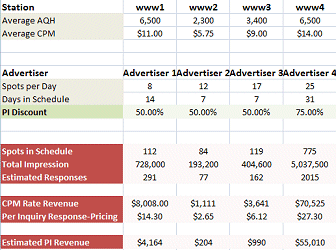

Pricing Radio Industry Per Inquiry Rates
On June 16, RBR posted an article by Gavin Ballas, VP-Business Development at Integrated Media Solutions. The title was "Of course you don't take PI advertising, but you should!" He ended with the words, "I'd love to hear from you." So let's dive in with a suggestion on how the radio industry can best use PI advertising without suffering a large loss in pricing.
| "A radio sales manager will be able to closely estimate revenue on a PI campaign by using this spreadsheet..." |
Per Inquiry advertising has been around for decades. It began gravitating away from major and medium markets in the 1990s, due to many stations being sold out on inventory, and managers (rightly) not being able to justify the revenue that PIs offered. Then came the internet with its plethora of ad networks and bold new approach to search engine keyword ad buying, which lowered the PI payout bar to pennies on each thousand people reached (CPM). |
I agree with Mr. Ballas. Per Inquiry is a pricing model that the radio industry needs to take a closer look at. We approach PI differently in how pricing for the radio industry should be set.
Mr. Ballas states: "...for the advertiser a performance based approach eliminates the risk and costs associated with the required optimizing of buying spots on new stations."
I'll add that the advertiser also benefits with performance-based advertising by putting the onus for delivering "response" on the media, when it should rest on the advertiser/agency.
Generating attention from today's consumers demands high incentive. (If you want response, let me sell your Lexus for $400. I'll get you response.) Agencies don't always offer the best creative. Done properly, incentive and creative have a profound effect on a station's potential earnings during a PI campaign. Yet they are seldom considered when a broadcaster is approached about running Per Inquiry.
Because PI ad buyers operate under a thought that they deserve unlimited impressions, what we mostly see with PI advertising is templated copy for different radio station formats. During a Per Inquiry campaign, there is also the thought that stations should abandon a long-held concept of frequency aiding recall while building brand awareness.
Radio - or television - has no systematic way for tracking reach upon airing a PI commercial, or for comparing reach to response, unless you're willing to depend on the client's count of calls received or orders filled. (There are other ways to do this that I'll explain in another article.)
Determining a fair market value on the price for response is difficult without a gauge on what response to expect. Too low, and the station gives away contact with its audience. Too high, and the advertiser balks. So where is the middle-ground?
Mr. Ballas' approach to setting rates is: "...we’d argue that a client should take their average cost per call from traditional media buying and increase it by at least 10% to come up with their payout for PI Media." I don't believe this is good enough.
Until we have good estimates on "response," I suggest that we use an average online ad response rate of 0.04% against impressions. It's only my educated guess, but this response rate is very close to what I've experienced over my 27 years in broadcasing.
I've created a spreadsheet that helps determine how to set Per Inquiry pricing for the radio industry. The beige-colored rows are where you plug numbers into the cells that fit your station. The green row is where you set the discount (off your station's average CPM rate). The rose-colored areas do automatic calculations.
 (Click to Expand)
(Click to Expand)
If a TV or radio industry GSM would like to discuss how to use this spreadsheet for their station, contact me through this link.
We're into a new world where accountability matters more. Spreading that accountability to the Per Inquiry market is every bit as important now as making sure the radio industry shares its response with clients who buy a reqular spot schedule.
You should begin learning how to track and account for response today. Tomorrow is right around the corner, and we're only getting deeper into this each passing day.
Like Gavin Ballis, I'm interested in your opinion and would love to hear from you. Just use the "contact" tab above.



 Home
Home